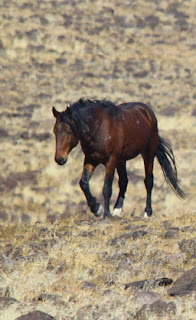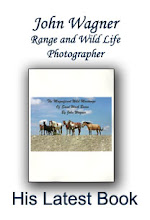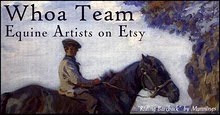 |
| "Running Through Lava Rocks" 5 by 7 inches Watercolor LindaLMartin Artist Original $65.00 11 by 8.5 inches In house Signed Prints: $35.00 To check availability email: info@llmartin.com |
One of the Questions I asked Mike Holmes, was, 'Why do you think your approach to wild horse management was so successful?"
“ I think it was because I listened to every body.” He said thoughtfully “ I was a public servant and I listened to everyone’s ideas and what they thought.” He was quick to insist that didn’t mean everyone agreed with all of his decisions or they way he handled things. That was to be expected. Mike knew how to be diplomatic and he knew how to generate working compromises. His ability to work with people and also his fair and compassionate treatment of wild horses has made him probably one of the best loved wild horse managers in Nevada.
Mike also came to the position armed with common sense and the law as well, as the ability to solve problems. While he was busy listening to people, he was also making good decisions that reflected well on his superiors and generated a lot of public support for them. His handling of the Virginia Range horses had a very positive Public Relations affect and he was always available to address groups and meet with individuals when asked.
“ When schools or organizations invited me to come and speak about what I did and the Virginia Range Horses, I always tried to make myself available.” Mike told me.
Mike’s job consisted of a number of management tasks. He was charged with maintaining the herd numbers so they didn’t grow to be too many to sustain on the available habitat. The state managed well over 300,000 acres for wild horses and under Mike the numbers stayed between 1200 and 1500 head of horses. This was unlike the BLM managed Pine Nut Mountain HMA which can only sustain 110 to 175 horses on about 90,000 acres. Mike was also empowered to remove nuisance horses and issue citations for people who insisted on feeding or harassing the horses.
“ Mostly what I tried to do was educate people, “ Mike said when talking of visiting people who had been sighted feeding wild horses. He explain to them how what they were doing was harmful to the horses and would prevent them from going off and finding food as they should in the wild. Then he told offenders that if he issued them a warning citation and they continued feeding the horses and someone was injured or killed because of what they had done, then because he had warned them, he would testify if they were charged, that they had been warned. “ I usually didn’t have to warn people twice” Mike insisted. He made them aware that the civil suits would probably be worse than the fines, if they continued feeding wild horses and someone was hurt or killed.
When horses would continue hanging around people’s homes, the public roads or other industrial areas where they or people could be hurt, Mike would trap the horses and release them in another part of the range far from towns and populated areas. If he had to remove the same horse or band 3 or 4 times then Mike would call one of several non-profit groups that work with wild horses and place the horse with them. The non-profits would then seek either sanctuary for them or to place them in adoptive homes.
“I would usually have to remove between 100 and 150 wild horses a year”Mike explained “ That kept the numbers steady. That was about the size of one year’s foal crop.” Mike told me that most of the removals were with traps or on horseback, however ,Mike did several round ups using contractor helicopters. "When we did those sort of removals we knew exactly how many horses we expected to remove from the range and we had per-arranged with one( or more) of the approved legitimate non-profits to take the horses in advance.”
According to Mike Holmes he always tried to do right by the horses first and foremost. “ The horses in our care were always taken care of. I can go on record that no horse ever went to a stock sale under my watch, not even the few domestic horses that we had to bring in occasionally.”
Also under his watch was the first PZP round up for Birth Control of Virginia Range Wild Horses. “ The contractor rounded up as many horses as they could in 2 or 3 days. We gave about 150 mares a dose of PZP. That kept the numbers from going up for a few years.”
Also under Mike Holmes’ watch was a special "Saddle Horse Program" in which non-profits were chosen for their horse training programs. Selected wild horses were accepted for training and then auctioned off much like the BLM auctions, with the Non-profit holding the title until the new owner had the horse for at least one year under approved supervision. “This protected buyers from taking the horses and turning around then selling them at auction for slaughter. “ He said.
Mike tried to use the best most successful and most humane management practices available and made himself available to help educate and solve problems.
Tomorrow : Groups Mike Holmes worked with and people that influenced and aided him in the good management of the Virginia Range Horses.
Special Thank-you to Mikel Ann Hettrick for the reference photography for today's painting.
Blogger's Note: A lot of people have misgivings when talking about rounding up wild horses and removing them from the range. Some people think that good range management should not include removing horses. However, if wild horses were not protected and removed they would soon over populate and that would lead to starvation and suffering , the like of which many advocates have neither seen nor experienced.
All forms of wild life in the United States have some sort of "culling" procedure and also a relocation plan for nuisance animals. One of the many things that impresses me about what Mike Holmes did was that instead of stock piling the wild horses that were removed from the range in hopes that people would come forward to adopt or provide sanctuary for them, he made sure that there was a place for each horse to go before it ever was taken from the range.
Placing horses to be removed before removal required working together with a number of people and organizations that didn't always agree on every aspect of range management. That he was able to do this, in my opinion, is part of Mike Holmes' success as a wild horse manager.










































